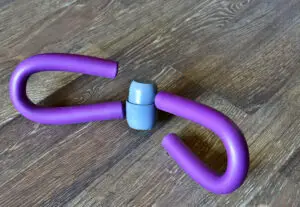Building a strong and sculpted backside is a goal for many people who work out regularly. An essential part of achieving this objective is focusing on the upper glutes, which contribute significantly to that desired ‘shelf butt’ look. Many individuals have a hard time targeting this specific area, and incorporating upper glute exercises into their fitness routine can help fill in those gaps.
Upper glute workouts are designed to isolate and strengthen this particular part of the gluteus muscles, contributing to a fuller, rounder appearance. By using a mix of weighted exercises and bodyweight movements, one can effectively target the upper glutes, enhance overall muscle tone, and improve their lower body strength.
A well-thought-out upper glute workout plan can help individuals say goodbye to a flat backside and embrace a more shapely and lifted rear.
Engaging in a combination of exercises such as barbell hip thrusts, single-leg Romanian dumbbell deadlifts, and fire hydrants is crucial in obtaining optimal results for the upper glute area. With consistency and attention to form, anyone looking to enhance their upper glute development can make significant progress towards sculpting an impressive backside.
The Anatomy of Glute Muscles
The gluteal muscles, commonly referred to as glutes, play a crucial role in various activities such as walking, running, and maintaining balance. This section offers an insightful look into the anatomy of the gluteal muscles, specifically focusing on the gluteus maximus, gluteus medius, and gluteus minimus.
Gluteus Maximus
The gluteus maximus is the largest and strongest muscle in the body, making up the bulk of the buttocks region. It primarily functions to extend and rotate the hip joint and is responsible for movements such as standing from a sitting position and climbing stairs. The upper portion of the gluteus maximus, often referred to as the upper glute, contributes significantly to the desirable “shelf” appearance in the gluteal area.
Gluteus Medius
Located beneath the gluteus maximus, the gluteus medius is a fan-shaped muscle that is essential for hip abduction (moving the leg away from the body) and maintaining pelvic stability during walking or running. It also helps maintain proper alignment and balance, reducing the risk of injuries.
The gluteus medius can be targeted through specific glute exercises, such as lateral band walks and clamshells, to enhance overall glute muscle development.
Gluteus Minimus
The gluteus minimus is the smallest of the three gluteal muscles and is situated beneath both the gluteus maximus and medius. Although small in size, it plays a vital role in hip abduction and internal rotation of the thigh. Strengthening the gluteus minimus contributes to better balance and stability, while also supporting the larger glute muscles in providing a well-rounded and aesthetically pleasing appearance.
Incorporating various glute exercises focused on targeting the gluteus maximus, gluteus medius, and gluteus minimus ensures a balanced and effective upper glute workout. Understanding the anatomy and functions of these muscles provides a solid foundation to build upon in developing a strong and well-toned posterior.
Benefits of Upper Glute Exercises
Improved Athletic Performance
Strengthening the upper glute muscles can lead to a significant improvement in athletic performance. The upper glute muscles play a crucial role in essential movements such as walking, running, and jumping. By targeting these muscles through specific exercises, individuals may see enhanced speed, agility, and overall performance in various sports and activities.
Pain Prevention
Incorporating upper glute exercises into a workout routine can help prevent and alleviate common issues such as back pain and knee pain. Weak glutes are often associated with low back pain, as they are unable to properly support the lower spine during daily activities.
By strengthening the upper glutes, an individual can achieve better posture and reduced discomfort. Similarly, strong glutes can help to prevent knee pain by providing better stability and alignment for the lower limbs during movement.
Enhanced Aesthetic Look
Many individuals aim to achieve a well-rounded and toned posterior, often referred to as a “glute shelf.” Focusing on upper glute exercises can help to build this desired appearance. As the gluteus maximus is the largest and most superficial of the gluteal muscles, targeted workouts can lead to a more sculpted and attractive look. This not only boosts self-confidence but also contributes to an overall healthier physique.
Essential Upper Glute Exercises
Squats
Squats are a fundamental exercise for targeting the upper glutes, and they come in various forms such as the back squat and the wider stance sumo squat. To perform a back squat, stand with your feet shoulder-width apart and lower yourself into a sitting position, keeping your chest up. The sumo squat requires a wider stance with toes pointing outwards, emphasising the activation of the upper glutes even more.
Lunges
Lunges are another effective exercise for working the upper glutes. Incorporate different variations such as forward lunges, reverse lunges, and lateral lunges to target different muscle groups in the glutes. Adding elements like dumbbells or resistance bands can increase the challenge and effectiveness of lunges for upper glute development.
Deadlifts
Deadlifts are a powerful exercise for strengthening the entire posterior chain, including the upper glutes. Both the Romanian deadlift and sumo deadlift variants can be used to target the upper glute muscles. In Romanian deadlifts, keep the feet hip-width apart and the knees slightly bent as you lower the weight. For the sumo deadlift, assume a wider stance similar to the sumo squat and focus on activating the upper glutes as you lift the weight.
Hip Thrusts
Hip thrusts are a highly focused exercise for isolating the glutes and upper glutes in particular. To perform a hip thrust, sit on the ground with your back against a bench, feet flat on the ground and a barbell or weight on your hips. Drive your hips upwards and squeeze the glutes at the top of the movement before lowering back down.
Abductions
Abductions are an effective exercise for targeting the outer glute muscles, directly impacting the upper glute area. Adding resistance bands around the knees or ankles adds difficulty and effectiveness to the exercise. Standing hip abductions and side-lying leg raises are both excellent choices for glute abductions.
Single-Leg Glute Bridge
The single-leg glute bridge is a unilateral exercise that focuses on one glute at a time, helping to improve muscle imbalances and effectively target the upper glutes. To perform a single-leg glute bridge, lie on your back with one foot flat on the ground, the other leg extended, and lift your hips off the ground, contracting your glutes at the top.
Bulgarian Split Squat
The Bulgarian split squat, also known as the rear foot elevated split squat, is a challenging lunge variation that amplifies the engagement of the upper glutes. Place one foot behind you on an elevated surface, such as a bench, and perform a lunge with the front leg while keeping the chest up and maintaining balance.
Quadruped Position
Exercises performed in the quadruped position, such as fire hydrants and donkey kicks, are highly effective at targeting the upper glutes. Assume a hands-and-knees position on the ground, with a neutral spine, and lift one leg to the side or upwards while keeping the knee bent and maintaining proper form. Using ankle weights or resistance bands can add difficulty to the movement and enhance the results for the upper glutes.
Equipments for Upper Glute Workout
Upper glute workouts require various types of equipment to effectively target the muscles and achieve the desired results. This section will discuss the different equipment options, including body weight, weights, resistance bands, barbells, dumbbells, and machines.
Body Weight
Bodyweight exercises are an effective and accessible way to target the upper glutes without the need for additional equipment. These exercises utilise your body weight as resistance, making them suitable for beginners to advanced fitness levels. Examples of bodyweight exercises for upper glute development include side-lying hip raises, single-leg glute bridges, and lunges.
Weights
Incorporating weights into your upper glute workout can help to increase the intensity, resistance, and effectiveness of the exercises. There are several types of weights that can be used for upper glute exercises:
- Dumbbells: These are versatile and easy to use for various upper glute exercises, such as dumbbell sumo squats, Romanian deadlifts, and dumbbell curtsy lunges.
- Barbells: Suitable for compound exercises like barbell hip thrusts and deadlifts, which target multiple muscles, including the upper glutes.
- Machines: Weight machines, such as the leg press and cable machine, provide targeted and consistent resistance, enabling you to focus on your upper glute muscles during specific exercises.
Resistance Bands
Resistance bands offer a portable and versatile option for upper glute workouts. They can be used to add resistance to a range of exercises, such as banded lateral walks, monster walks, and quadruped kickbacks. Resistance bands come in various strengths, allowing you to progress as your fitness level increases.
Barbells
Barbells are effective equipment for targeting the upper glutes due to their ability to handle heavier weights and engage multiple muscle groups during compound exercises. Key barbell exercises for upper glute development include barbell hip thrusts, deadlifts, and squats, which help to stimulate and strengthen the upper glute muscles.
Dumbbells
Dumbbells provide an additional challenge to upper glute workouts, allowing you to target specific muscles more effectively. Dumbbell exercises for the upper glutes include dumbbell sumo squats, Romanian deadlifts, and curtsy lunges. These exercises can be easily incorporated into your existing workout routine and adjusted for increased resistance as your strength improves.
Machines
Weight machines offer a guided and controlled workout experience, which can be particularly beneficial for beginners or those looking for targeted isolation exercises. Machines such as the leg press, cable machine, and Smith machine can be used to perform upper glute exercises, allowing for precise and consistent resistance throughout the movement. This can help to effectively engage and strengthen the upper glute muscles.
Meal Plan for Muscle Growth
A well-rounded meal plan designed for muscle growth should prioritise sufficient protein intake, as it plays a crucial role in repairing and rebuilding muscles. Aim for approximately 2 grams of protein per kilogram of body weight each day 1. This means someone weighing 55 kg would require around 110 grams of protein daily. Diversify your protein consumption with various sources such as lean meats, dairy products, beans, and legumes.
Carbohydrates are essential for fuelling workouts and promoting muscle growth 1. They supply energy during high-intensity exercise and help replenish muscle glycogen stores. Consuming a balanced mix of simple and complex carbs ensures a steady energy supply throughout the day. Examples of carbohydrate sources include whole grains, fruits, vegetables, and starchy foods such as potatoes and rice.
Healthy fats should not be ignored in a meal plan for muscle growth. They support hormonal balance, reduce inflammation, and provide energy. Opt for unsaturated fats found in avocados, nuts, seeds, and olive oil.
Here’s a sample daily meal plan for muscle growth:
Breakfast:
- Scrambled eggs with spinach and tomatoes
- A bowl of oatmeal topped with berries and a dollop of Greek yoghurt
- A glass of milk or plant-based alternative
Lunch:
- Grilled chicken breast or tofu with a mixed vegetable stir-fry
- Brown rice or quinoa
- A side of avocado
Snack:
- A handful of almonds or a protein bar
- A piece of fruit, such as a banana or an apple
Dinner:
- Baked salmon or a bean-based stew
- Roasted sweet potatoes and steamed broccoli
- A mixed leafy green salad with a light dressing
Post-workout:
- A protein shake with a ratio of 0.4 to 0.55 grams of protein per kilogram of body weight per meal
- A small serving of simple carbs such as a fruit smoothie or a slice of whole-grain toast with honey
To achieve optimal results, consider consuming three to six meals per day, depending on your desired weight and body composition goals. This prevents muscle breakdown and promotes a steady supply of essential nutrients for muscle growth. Remember to adjust portion sizes and meal frequencies according to your unique dietary needs and preferences.
Routine and Consistency in Workouts
Warmup
Warming up before an upper glute workout is essential for preparing the muscles and enhancing overall performance. A proper warmup helps increase blood flow, decrease the risk of injury, and improve muscle engagement. To get started, incorporate light cardio activities like brisk walking or jogging, dynamic stretching, and focused activation exercises targeting the glutes, for example, banded clamshells or glute bridges.
Workout Plan
A well-structured workout plan is key to effectively building and sculpting the upper glutes. First, select specific exercises that target the upper glute muscles, such as lateral lunges, hip thrusts, and Bulgarian split squats, as described in this article. Aim for 3-4 sets of 8-12 repetitions with adequate rest periods between sets.
To further enhance progress, consider adding resistance to your routine in the form of dumbbells, resistance bands, or barbells. Implement a progressive overload strategy, gradually increasing the weight, sets, or repetitions over time. This will continually challenge your muscles and stimulate growth.
For optimal results, schedule at least 2 upper glute workout sessions per week, ensuring proper recovery between sessions to avoid overtraining.
Maintaining Consistency
The key to a sculpted upper glute is consistency in both training and nutrition. Establish a consistent workout routine with a designated schedule, making it a priority in your weekly agenda. Additionally, track your workouts, setting achievable goals and monitoring your progress. This will not only keep you motivated but also allow you to adjust your plan accordingly.
Nutrition also plays a crucial role in building the upper glutes. Provide your body with the necessary nutrients by increasing your calorie and protein intake in line with your goals. A balanced diet, rich in essential vitamins and minerals, will ultimately support muscle growth and recovery.
In summary, following a systematic upper glute workout plan while maintaining consistency in training and nutrition will greatly contribute to your overall progress and help you achieve that coveted glute shelf.
Progressive Overload in Glute Workout
Progressive overload is a fundamental principle in strength training, ensuring consistent progress in both muscle growth and strength development. It involves gradually increasing the stress placed on the muscles during workouts, which can be achieved by increasing the weight, number of repetitions, or sets. This concept is also effective in targeting the upper glutes to help develop a well-rounded glute shelf.
In order to effectively apply progressive overload to an upper glute workout, there are several strategies that can be employed. The first and most common approach is to increase the weight lifted during exercises such as hip thrusts, lateral lunges, and Bulgarian split squats1. When aiming to increase weight, it is crucial to maintain proper form to prevent injury.
Another method of incorporating progressive overload is by increasing the number of sets or repetitions for each exercise2. This allows for greater volume and challenge to the muscles, leading to further growth and strength gain. As the body adapts to the current training stimulus, increasing the number of sets or repetitions ensures that the muscles continue to be pushed and developed.
Aside from increasing weight and volume, reducing rest intervals between sets can also be an effective way to apply progressive overload3. Shortening rest periods requires the muscles to work harder, as they have less time to recover between sets. This can lead to increased muscle endurance and growth, promoting better development of the upper glutes.
Overall, implementing progressive overload in an upper glute workout is essential for consistent progression and growth. By regularly increasing the intensity, volume, or decreasing rest intervals, it is possible to effectively target the upper glutes, leading to improved strength and a well-rounded glute shelf.
Common Errors in Performing Glute Exercises
One of the most frequent mistakes people make when performing glute exercises is focusing solely on squatting. Squats can activate the glutes, but they primarily target the lower subdivision of the gluteus maximus, while other exercises can offer better activation of the upper glutes.
Another common error is allowing the lower back to cave, especially during exercises like donkey kicks. To avoid this problem and ensure proper glute engagement, maintain a neutral spine throughout the movement and avoid arching the lower back excessively.
A similar mistake is hyperextending the lower back during glute bridges, which can lead to pain and reduced effectiveness of the exercise. To correct this, focus on squeezing the glutes at the top of the bridge, rather than thrusting your hips too high.
In some upper glute exercises, such as squats, putting too much stress on the knees is a common issue. This can happen when people bend their knees as they start the squat, rather than engaging their hips and glutes first. To avoid unnecessary stress on the knees and improve form, initiate the movement by pushing your hips back and maintaining a neutral spine.
Lastly, exercise selection and technique are crucial for the effective growth of the glutes. Often, individuals choose the wrong types of exercises or perform them with incorrect form. To ensure you’re targeting your glutes appropriately and promoting growth, pay attention to technique adjustments and choose a variety of exercises that engage your upper and lower glutes effectively.
Adapting Glute Workout for a Sedentary Lifestyle
Incorporating an upper glute workout into a sedentary lifestyle can be challenging, but it is possible with some simple adjustments. With increasingly busy modern lives, most people spend their days sitting at desks, which can lead to weak glute muscles. By incorporating exercises that target the upper glutes into daily routines, individuals can effectively combat the adverse effects of prolonged sitting.
To adapt a glute workout for a sedentary lifestyle, one can start by incorporating exercises that do not require any equipment. This makes it easier to perform such workouts at home or in the office without the need for a gym membership. Examples of no equipment upper glute exercises include:
- Glute bridges: Lie on the back with knees bent upwards and feet flat on the ground. Lift the hips upward, pushing down into the heels and squeezing the glutes. Hold for a moment, then slowly release back to the ground. Repeat for one to three sets of 12 to 20 reps.
- Standing hip abduction: Stand with feet hip-width apart. Shift weight onto one leg and lift the other leg out to the side, keeping the foot flexed. Be mindful of maintaining a neutral spine and not leaning to one side. Perform one to three sets of 12 to 20 reps on each leg.
- Seated leg lifts: Sit on a chair with a straight back. Keeping one leg bent, lift the other leg off the ground and straight out in front of the body. Hold for a few seconds, then lower the leg. Perform one to three sets of 12 to 20 reps on each leg.
By scheduling regular breaks during the day to perform these exercises, individuals with sedentary lifestyles can slowly build up the strength and endurance of their upper glutes. Set a timer to remind oneself to stand up, walk around, and perform a few targeted glute exercises every hour or so.
In addition to performing upper glute exercises, individuals should also aim to incorporate general physical activity into their daily routines. Examples include taking the stairs instead of the lift, going for a brisk walk during lunch breaks, or cycling to work. These activities will complement a targeted upper glute workout and help counteract the negative effects of a sedentary lifestyle.
My name is Ellis Francis and I have been a personal fitness trainer, sports nutritionalist and health and fitness advisor for over 25 years. I am the lead health and fitness advisor at https://awellnessbody.com.







